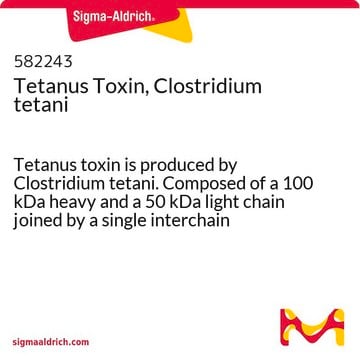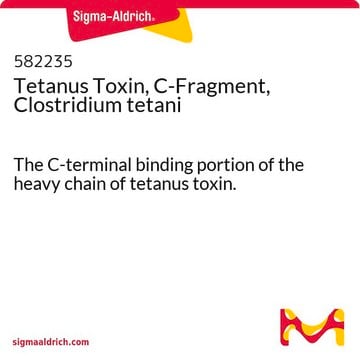T3194
Tetanus toxin
from Clostridium tetani, cleaves synaptobrevin (VAMP-2)
About This Item
Productos recomendados
product name
Tetanus toxin from Clostridium tetani,
mol wt
150 kDa (heavy chain (100 kDa) and a light chain (50 kDa) connected through an interchain disulfide bond)
Quality Level
solubility
H2O: soluble
storage temp.
2-8°C
Gene Information
Clostridium tetani E88 ... tetX(1061100)
General description
Application
Biochem/physiol Actions
Preparation Note
Reconstitution
Analysis Note
signalword
Danger
hcodes
Hazard Classifications
Acute Tox. 1 Oral - Acute Tox. 2 Inhalation - STOT SE 1
target_organs
Central nervous system
Storage Class
6.1A - Combustible acute toxic Cat. 1 and 2 / very toxic hazardous materials
wgk_germany
WGK 3
flash_point_f
Not applicable
flash_point_c
Not applicable
ppe
Eyeshields, Faceshields, Gloves, type P3 (EN 143) respirator cartridges
Certificados de análisis (COA)
Busque Certificados de análisis (COA) introduciendo el número de lote del producto. Los números de lote se encuentran en la etiqueta del producto después de las palabras «Lot» o «Batch»
¿Ya tiene este producto?
Encuentre la documentación para los productos que ha comprado recientemente en la Biblioteca de documentos.
Nuestro equipo de científicos tiene experiencia en todas las áreas de investigación: Ciencias de la vida, Ciencia de los materiales, Síntesis química, Cromatografía, Analítica y muchas otras.
Póngase en contacto con el Servicio técnico










